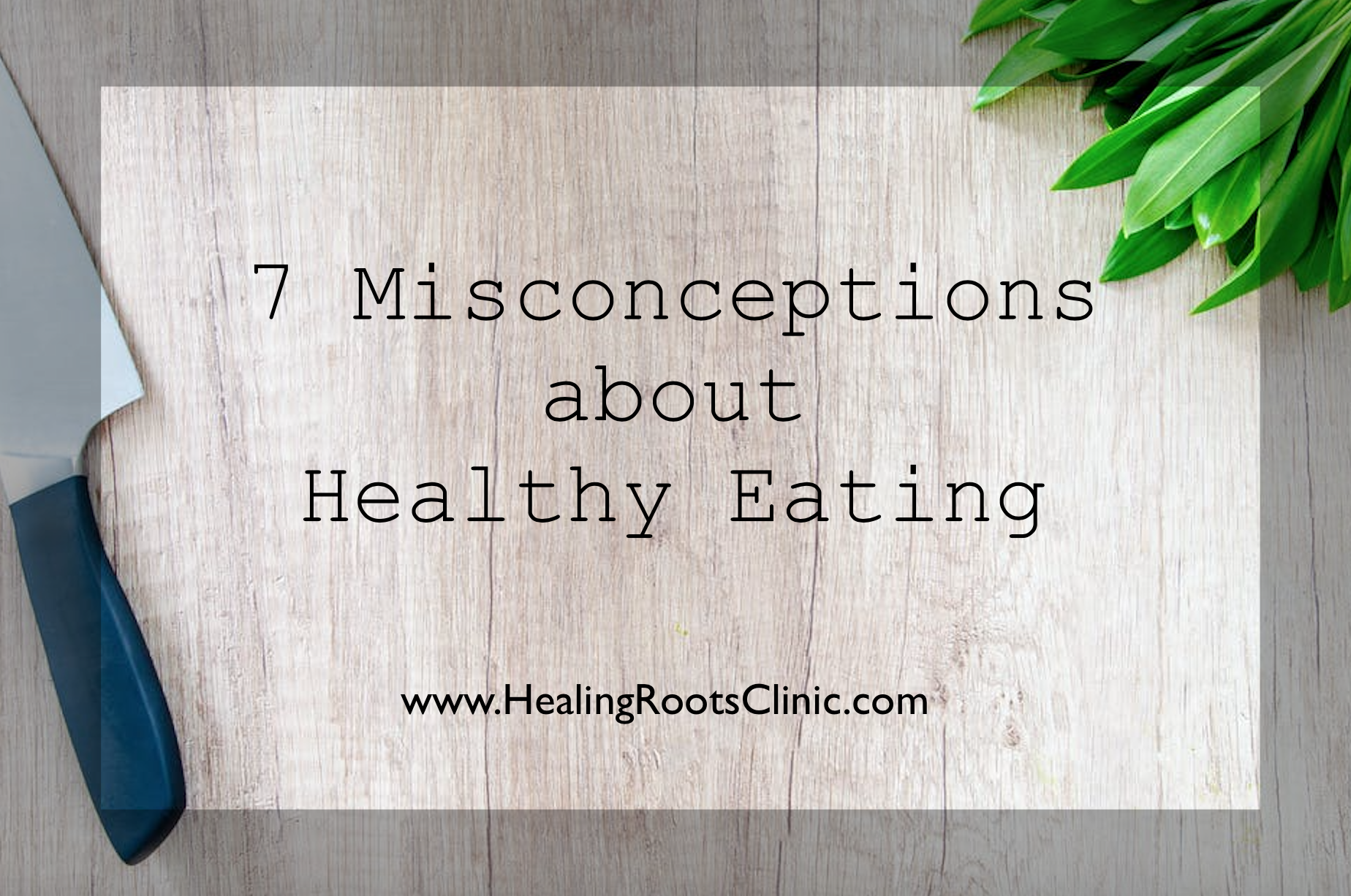 Every patient that steps into my office gets asked about what they eat. New patient paperwork includes a section asking what is typically eaten for breakfast, lunch, dinner, and snacks. I also ask whether or not she is satisfied with her current diet.
Every patient that steps into my office gets asked about what they eat. New patient paperwork includes a section asking what is typically eaten for breakfast, lunch, dinner, and snacks. I also ask whether or not she is satisfied with her current diet.
It’s easy to make suggestions when someone’s eating a typical Standard American Diet (SAD) full of “meats and sweets” and they want to change that. It’s much more tricky when she says she’s satisfied with her current diet and I realize we disagree as to what constitutes a healthy diet.
Here are 7 Misconceptions about Healthy Eating that I find myself commonly addressing with patients.
Healthy Eating Misconception #1 – “I drink organic milk.”
 Yes, organic milk is better than non-organic milk because the animals are raised without added hormones and antibiotics, the latter of which may be contributing to superbugs. Organic milk also has a more favorable ratio of omega-6 to omega-3 fatty acids (1). However, both organic and conventional milk remains in the five most common food intolerances and allergies, and probably second only to gluten.
Yes, organic milk is better than non-organic milk because the animals are raised without added hormones and antibiotics, the latter of which may be contributing to superbugs. Organic milk also has a more favorable ratio of omega-6 to omega-3 fatty acids (1). However, both organic and conventional milk remains in the five most common food intolerances and allergies, and probably second only to gluten.
Eczema, acne, joint aches, muscle aches, irritable bowel syndrome (IBS), and constipation are just some of the conditions I have seen clear up when a patient removes milk from their diet. Consider eliminating all dairy for one month (milk, butter, yogurt, ice cream, cream, etc) to see if you might be intolerant. Reintroduce each type of dairy one at a time. Eat at least 3 servings over a three-day period and be mindful of changes you notice in your body.
Aside from causing inflammation in the body, the milk on your supermarket shelf is not as nutrient-rich as you’ve been led to believe. The pasteurization process depletes both organic and conventional milk of nutrients including vitamins C and B6, and minerals like manganese, copper, and iron. Pasteurization also kills the heat-sensitive enzymes and vitamins found in raw milk and alters protein structure. It is likely these alterations that contribute to the difficulties we have in digesting milk. Culturing dairy encourages good bacteria that counteract some of these negative effects of pasteurization.
What I recommend…
If your body tolerates them well, organic butter from pasture-raised cows and cultured, organic, no-sugar-added dairy like yogurt and kefir are worthwhile dairy products to consume. Dairy products made from goats or sheep, plant-based milk like almond or coconut, cheese made from nuts like cashews, and coconut cream and coconut instead of heavy cream or butter are great substitutions in moderation for those who cannot tolerate any cow dairy.
Healthy Eating Misconception #2 – “I only cook with olive oil.”
 Organic extra virgin olive oil is a great source of plant sterols which have been shown to be beneficial to the cardiovascular system. However, like most other plant oils, olive oil can go rancid if not processed and stored correctly.
Organic extra virgin olive oil is a great source of plant sterols which have been shown to be beneficial to the cardiovascular system. However, like most other plant oils, olive oil can go rancid if not processed and stored correctly.
UC Davis has a special Olive Oil Center that has studied the quality of common extra virgin olive oils on the market. In their 2011 study, they found that many of the top brands on the market do not meet quality standards for several reasons:
- oxidation from exposure to elevated temperatures, light, and/or aging;
- adulteration with cheaper refined olive oil;
- and poor quality due to using damaged and overripe olives and/or processing flaws.
Rancid oils cause inflammation in the body and promote free radical formation and weak cellular membranes. Cell membranes are the packaging surrounding all of your cells and they are an important surface for communication in your body.
What I recommend…
Choose organic, cold-pressed olive oil in dark glass bottles and then store them in a dark cupboard to add to salads and lightly sautéed foods. Consider using avocado oil, coconut oil, CSPO certified sustainable red palm oil, lard from pastured pigs, and butter from pastured cows to add a variety of healthy nutrients when cooking foods at higher temperatures.
Healthy Eating Misconception #3 – “I never cook meat at home and only eat it in restaurants.”
 I believe that a statement like this is making the assumption that we would all be healthier if we ate a vegetarian diet and eating meat only in restaurants helps people to limit meat consumption. I see two main issues with this logic. First, not everyone does well on a vegetarian diet and eating meat rarely may or may not be a good dietary guideline for you personally. Second, very few restaurants buy quality meat and animal products. The source of the meat, including how the animal is raised, has a huge impact on whether or not meat is a healthy meal option.
I believe that a statement like this is making the assumption that we would all be healthier if we ate a vegetarian diet and eating meat only in restaurants helps people to limit meat consumption. I see two main issues with this logic. First, not everyone does well on a vegetarian diet and eating meat rarely may or may not be a good dietary guideline for you personally. Second, very few restaurants buy quality meat and animal products. The source of the meat, including how the animal is raised, has a huge impact on whether or not meat is a healthy meal option.
Chickens, cows, lambs, turkeys, and pigs that are raised on pastures provide more nutrients to the people consuming them than their conventionally raised counterparts. When these animals are truly* pastured or free-range, they dine primarily on grasses and insects which are their natural diets. This makes the meat, fats, milk, and eggs that come from them more packed with nutrients including healthy omega-3 fatty acids and vitamin A. Animals raised in conventional settings like feedlots and warehouses dine mostly on corn and soy, two foods that commonly contribute to inflammation and other health issues in animals and humans alike.
*The terms natural, free-range, and organic, especially when referring to chickens, do not always mean these animals are outside living and dining on green grass. Free-range can mean that the animal is cage-free but still living indoors with very little room to roam.
What I recommend…
When you prepare meat at home rather than eating it in restaurants you have full control over the source and quality of the fish, eggs, dairy and meat you are eating. (PS -I really like the quality of US Wellness Meats and Kettle & Fire’s Organic Bone Broth.) That being said, I think it’s a wonderful thing to support local farm-to-table restaurants that source their pastured meat and other animal products from organic farms.
Healthy Eating Misconception #4 – “All the bread and cereals I buy are gluten-free and I’ve even tried rice pasta.”
 Gluten, a protein found in wheat, spelt, kamut, farro, barley, and rye, is hard for some people to digest and is linked to inflammation. Going gluten-free can be a daunting task and expensive if you try to substitute common pantry staples traditionally based on wheat one-for-one with gluten-free products.
Gluten, a protein found in wheat, spelt, kamut, farro, barley, and rye, is hard for some people to digest and is linked to inflammation. Going gluten-free can be a daunting task and expensive if you try to substitute common pantry staples traditionally based on wheat one-for-one with gluten-free products.
Most of the gluten-free products on the market have very little nutritional value—you only need to look at the ingredients list of available gluten-free bread options to realize that most are made from highly refined flours and are the nutritional equivalent of white bread: white rice flour, corn starch, potato starch, and tapioca starch.
When I counsel patients on tactics for going gluten-free, I recommend that they choose whole grains or simply avoid grains and eat more vegetables instead of reaching for the expensive gluten-free substitutes. What is a whole grain? A whole grain is when you eat the kernel of grain instead of the flour it has been ground into.
What I recommend…
Think outside the box… literally. Instead of buying boxed gluten-free pasta substitutes or boxed cardboard-like dry cereal that claims “whole grains,” try cooking with amaranth, brown rice, buckwheat, millet, oats, polenta, quinoa, sorghum, and teff. Or, as I said before, skip grains altogether and eat more fruit and veggies.
Healthy Eating Misconception #5 – “I drink diet sodas.”
Many people believe that if the nutrient panel on the back of a package says that there are no calories then it must be good, right? Yes, if the can or box contains pure water.
Nutrition, and even weight loss, is much more complex than simply counting calories. Diet soda consumption has been associated with the development obesity, type 2 diabetes, stroke, dementia (2), and fatty liver disease (3).
So then, are regular sodas better choices? Yes and no. It is well-known that the high fructose corn syrup in major soda brands is highly implicated in the obesity epidemic. Corn, even when in the form of corn syrup, is another one of the top five food intolerances. Avoid all major soda brands; they are laden with corn syrup and usually contain colorings and flavorings as well.
What I recommend…
 In my opinion, an occasional small serving of soda sweetened with evaporated cane juice or a natural sweetener is a totally acceptable treat. These include Sanpellegrino, Reed’s, Izze, and such. Even better than these, try having a fermented drink like kombucha or KeVita, or simply have sparkling mineral water with a twist of citrus.
In my opinion, an occasional small serving of soda sweetened with evaporated cane juice or a natural sweetener is a totally acceptable treat. These include Sanpellegrino, Reed’s, Izze, and such. Even better than these, try having a fermented drink like kombucha or KeVita, or simply have sparkling mineral water with a twist of citrus.
Healthy Eating Misconception #6 – “I eat tons of fruit.”
Yes, fruits have many excellent nutrients in them and are easier for many people, especially children, to eat than vegetables. Most Americans have diets with an abundance of sugar in it, both natural and refined, and lowering overall sugar intake is a good goal regardless of the source. Fruit should be a part of any healthy well-rounded diet but how much you personally should eat depends on several factors.

Since fruit is the whole-food source of sugar in nature, diabetics and those trying to lose weight should limit fruit to small, occasional servings and choose lower carbohydrate fruits, like berries, while passing on high sugar, high carbohydrate tropical fruits like bananas. Individuals with weaker digestion or lots of inflammation do better with cooked rather than raw fruits and should experiment with whether they digest fruit better away from or at meals.
If you experience hypoglycemia (low blood sugar), it is usually best to limit fruit to smaller servings and eat it with healthy fat, like nut butter, or have fruit after meals as a simple dessert. Symptoms of hypoglycemia include shakiness, dizziness, irritability, headaches, sweating, and anxiety.
What I recommend…
It is ideal to retrain your taste buds and body to think of fruit as the sweet naturally sugar-packed dessert it is rather than thinking of eating fruit as your main way to meet daily requirements for fruits and vegetables while foregoing those leafy greens. I generally make an individualized fruit recommendation for patients somewhere between 3 servings per day to 3-4 pieces per week. That’s a wide range—I know! If whole fruits and small amounts of honey and maple syrup are the main sources of sugar in your well-rounded diet and you eat minimal amounts of processed foods, more fruit can be enjoyed.
Healthy Eating Misconception #6 – “I eat a ton of vegetables.”
 This IS actually great! I only mention it because many people need to do a reality check on how many servings constitute a “ton” of vegetables. Pause for a minute and consider the variety and quantity of vegetables (not fruit!) you’ve eaten over the last 48 hours. For some of my patients who claim to love to eat vegetables, they think of 1 or 2 servings per day as a “ton.” If you don’t know, think about writing down or keeping track on an app the number of veggies you eat over the course of 3 days and see what you come up with.
This IS actually great! I only mention it because many people need to do a reality check on how many servings constitute a “ton” of vegetables. Pause for a minute and consider the variety and quantity of vegetables (not fruit!) you’ve eaten over the last 48 hours. For some of my patients who claim to love to eat vegetables, they think of 1 or 2 servings per day as a “ton.” If you don’t know, think about writing down or keeping track on an app the number of veggies you eat over the course of 3 days and see what you come up with.
What I recommend…
Ideally, you should be eating 7-10 servings of vegetables each day. The definition of a serving varies. I generally define a serving as a heaping cup of greens (think chopped kale or lettuce) or a half-cup of more dense vegetables (think shredded beets or winter squash). I have some ideas of how to include more brassica veggies each day (even at breakfast!) in this post from my Spring Detox blog series.
Also, I love this TED Talk with Dr. Terry Wahls, MD that touts the merits of fresh produce over both pharmaceuticals and synthetic vitamins in her journey to healing from multiple sclerosis (MS). And Dr. Josh Axe has a great post about foods (including lots of veggies) that are the most potent cancer-fighters, so be sure to pack them in!
What About You?
If you’ve found yourself saying a few of these 7 misconceptions about healthy eating, that’s totally fine. At the end of the day, I simply want to help people feel better.
Whether you think that making changes to your diet and other lifestyle habits can help, or you’re well-seasoned in taking care of your health and want to fine-tune some things, we can work together to reach your health goals. I specialize in issues related to thyroid, autoimmunity, digestion, chronic congestion, and adult acne, and offer a free “Is this a good fit?” office or phone consult.

well for me , I always see to it that I have dehydrated fruits and veggies in the fridge.Lemon water works great for me too. I also always have olive and coconut oil in the kitchen because of tons of benefits link to them..